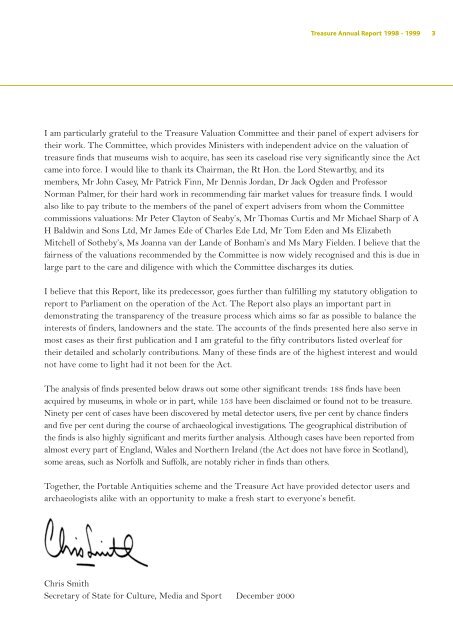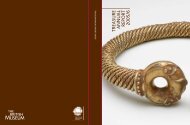Treasure Annual Report 1998-1999 - Portable Antiquities Scheme
Treasure Annual Report 1998-1999 - Portable Antiquities Scheme
Treasure Annual Report 1998-1999 - Portable Antiquities Scheme
You also want an ePaper? Increase the reach of your titles
YUMPU automatically turns print PDFs into web optimized ePapers that Google loves.
<strong>Treasure</strong> <strong>Annual</strong> <strong>Report</strong> <strong>1998</strong> - <strong>1999</strong><br />
I am particularly grateful to the <strong>Treasure</strong> Valuation Committee and their panel of expert advisers for<br />
their work. The Committee, which provides Ministers with independent advice on the valuation of<br />
treasure finds that museums wish to acquire, has seen its caseload rise very significantly since the Act<br />
came into force. I would like to thank its Chairman, the Rt Hon. the Lord Stewartby, and its<br />
members, Mr John Casey, Mr Patrick Finn, Mr Dennis Jordan, Dr Jack Ogden and Professor<br />
Norman Palmer, for their hard work in recommending fair market values for treasure finds. I would<br />
also like to pay tribute to the members of the panel of expert advisers from whom the Committee<br />
commissions valuations: Mr Peter Clayton of Seaby’s, Mr Thomas Curtis and Mr Michael Sharp of A<br />
H Baldwin and Sons Ltd, Mr James Ede of Charles Ede Ltd, Mr Tom Eden and Ms Elizabeth<br />
Mitchell of Sotheby’s, Ms Joanna van der Lande of Bonham’s and Ms Mary Fielden. I believe that the<br />
fairness of the valuations recommended by the Committee is now widely recognised and this is due in<br />
large part to the care and diligence with which the Committee discharges its duties.<br />
I believe that this <strong>Report</strong>, like its predecessor, goes further than fulfilling my statutory obligation to<br />
report to Parliament on the operation of the Act. The <strong>Report</strong> also plays an important part in<br />
demonstrating the transparency of the treasure process which aims so far as possible to balance the<br />
interests of finders, landowners and the state. The accounts of the finds presented here also serve in<br />
most cases as their first publication and I am grateful to the fifty contributors listed overleaf for<br />
their detailed and scholarly contributions. Many of these finds are of the highest interest and would<br />
not have come to light had it not been for the Act.<br />
The analysis of finds presented below draws out some other significant trends: 188 finds have been<br />
acquired by museums, in whole or in part, while 153 have been disclaimed or found not to be treasure.<br />
Ninety per cent of cases have been discovered by metal detector users, five per cent by chance finders<br />
and five per cent during the course of archaeological investigations. The geographical distribution of<br />
the finds is also highly significant and merits further analysis. Although cases have been reported from<br />
almost every part of England, Wales and Northern Ireland (the Act does not have force in Scotland),<br />
some areas, such as Norfolk and Suffolk, are notably richer in finds than others.<br />
Together, the <strong>Portable</strong> <strong>Antiquities</strong> scheme and the <strong>Treasure</strong> Act have provided detector users and<br />
archaeologists alike with an opportunity to make a fresh start to everyone’s benefit.<br />
Chris Smith<br />
Secretary of State for Culture, Media and Sport December 2000<br />
3





